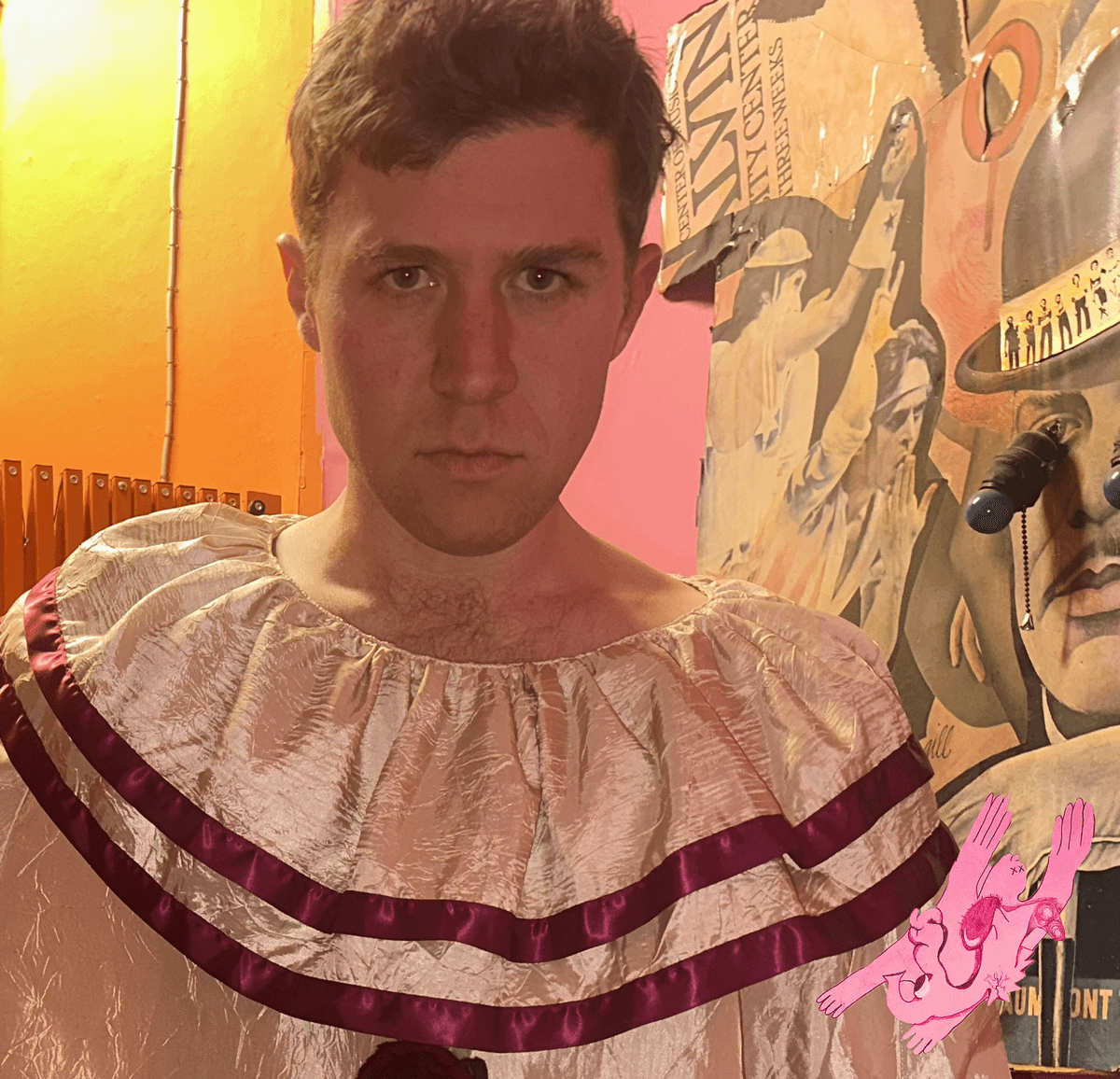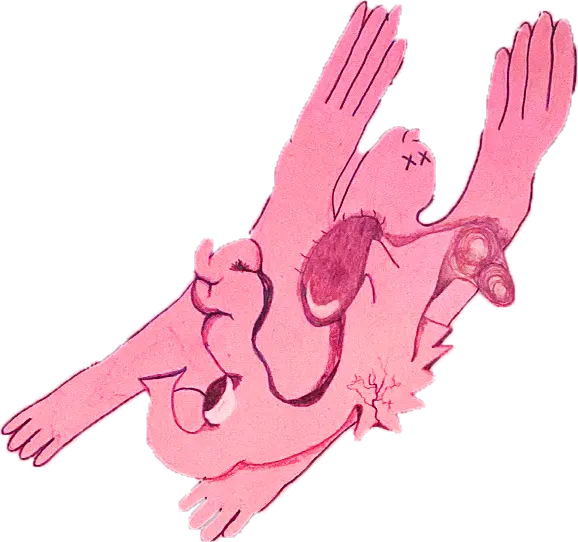IMAGE-MAKING
Gideon Jacobs

TESS POLLOK: You’re a writer with bylines in The New York Times and The New Yorker, among others. In both fiction and nonfiction formats your work is mostly concerned with unpacking the image and image-making. I appreciated your recent commentary on propaganda and the uncanny valley under the Trump administration in the LA Review of Books.
GIDEON JACOBS: It’s funny, with hindsight, I can see that pretty much all of my work over the last decade or so—fiction, nonfiction, art, performance, whatever—has been in some way related to a long held feeling that humans are uniquely vulnerable to images, that images are a tricky technology for our species. When I was in my early twenties, I remember feeling a sense of timeless camaraderie when realizing, from Plato to the Old Testament to Buddhist and Hindu philosophy, that our relationship to images has been a concern since forever. And long before it became a hobbyhorse for 20th century academia and media theorists, it was a spiritual concern. Personally, I believe an ideal relationship with images is to recognize them for what they are so as to allow one to hold them lightly and not take their contents too seriously. But the show at Earth is about a guy who does NOT feel that way. It “stars” Father Bartholomew Mary, this nutty minor character from a novel I’m writing. He's a Second Commandmentment fundamentalist preacher who thinks images are at the root of ALL of society’s problems. Andy Kaufman is one of my favorite artists. This show is kind of a way for me to experiment with softcore Kaufmanian commitment, and hopefully exorcise some of the more iconoclastic and image-anxious parts of my brain.
POLLOK: Where did your obsession with images begin?
JACOBS: Probably doesn’t take a brilliant psychoanalyst to conclude it might have something to do with the fact that I was a professional actor as a kid. I think there’s a reason that a lot of the child actors die young. In my opinion, it is psychologically dangerous for one’s image of self to outpace development of one’s sense of self. I sometimes morbidly joke—though really do believe it—that if I’d gotten famous as a kid, I’d be dead.
After college, even though I wanted to be a writer, it seems some part of me was drawn to images. My first job was at Magnum Photos. I quit that great job in the arts in my twenties mostly because I was depressed and felt like I needed to start writing. Luckily, an editor at VICE Magazine asked me to write a column about photography. That was some of my first published work. I still write about photography occasionally, but these days I’m mostly interested in images as a technology. I care less and less about an image’s actual contents. The medium has just totally defined our era and I see it everywhere I look.
POLLOK: What makes images definitive of our era?
JACOBS: Although Father Mary takes it to ridiculous hyperbolic extremes, I do think a lot of the world’s problems can be traced back to images replacing the written word in many ways, and ability and/or habit to over-invest in and/or over-identify with images. Supercharged by the internet, it seems like we’ve transitioned from living in an image-saturated world, into a full-blown image world, a kind of free-floating hyperreality. The Self has inextricably blended with self-image. And a lot of the time it fits like an itchy sweater. I think this has something to do with the world’s current unnamable weirdness, the ubiquitous ennui and alienation, the anxiety and precarity.
POLLOK: It’s interesting you bring this up because we recently interviewed the model and fashion designer Ava Pearlman who mentioned that her experiences in modeling led her to develop problems with self-image and dissociation.
JACOBS: I actually read Ava’s interview when I was browsing the magazine before we began chatting, and there’s a lot of similarity between what she’s talking about and what I’m talking about. I think we are living in a dissociative moment; it’s telling that ketamine is this decade's drug of choice. Dissociation is an understandable mechanism when we feel our living three-dimensional Self being flattened into a lifeless image. Dissociation as self-preservation from self-image.
POLLOK: I didn’t know you were working on a novel. What is your novel about?
JACOBS: It’s a strange but, I hope, enjoyable book. There are three timelines. One in the past, Byzantium, during a period of history known as The First Iconoclasm. Sort of palace intrigue, sex, violence, backstabbing, almost Game of Thrones-y at times. There is a present day timeline, a kind of normie advertising guy living now, 20 years into this strange global experiment of a mainstream internet and ubiquitous social media. There’s also a sci-fi future plotline. They are all named Leo. (Leo III was emperor during the First Iconoclasm.)
POLLOK: How is navigating the freelance writing landscape going for you?
JACOBS: Magazine writing is a pretty small percentage of my professional life. Financially, it’s not really a profession for nearly anyone but a glorified hobby. I try to make sure young writers know this is the reality of legacy media. Everyone who isn’t on a staff has other sources of income or comes from money. I was only able to do it because I earned enough as a professional kid. I was in SAG long enough that I'll get a pension when I’m an old man. I also do some copywriting and brand consulting on the side.
It's funny to be a writer who writes about how humans—and text—are no match for images. People are reading more than ever, yes, but it's almost like they’re engaging with text as images, expecting to get meaning, value, and story from it at a glance. I know book sales are holding strong but I assume they're surviving in the same way that vinyls are. Is that sustainable, for books to be mostly valued as an object rather than for their contents? I feel it in myself. I can’t read if images are in the room. Shit, I can barely function if I’ve spent too much time on my phone a few days in a row. So I get it.
POLLOK: I do think the proliferation of literary magazines and DIY publications is good, in general. To inject a bit of positivity into this conversation. I think it democratizes access to art-making for a lot of people. One of the advantages of having such a large online ecosystem to disseminate art is that you have greater access to people who wouldn’t traditionally have been considered readers.
JACOBS: I agree. I’ve been interested in fanfiction lately. There’s so much energy and writing and reading happening there, but it’s almost entirely online, and the internet seems to have some intrinsic qualities to it, some positive, some negative. That said, I think it’s pretty clear that being “very online” makes people—for lack of a better word—sick. Like, how many people do you know that who you would describe as “very online” seem…well?
POLLOK: Almost none. But isn’t it correlated with schizophrenia? That’s where the schizo-posting trend came from, shitposting. It’s associated with mental illness.
JACOBS: Did you know there’s never been a single diagnosed case of schizophrenia in a human being born blind?
POLLOK: No. That’s the single strongest evidence for your thesis about images that I’ve ever heard.
JACOBS: There are theories about it. It’s going to come up in my show at EARTH. In some ways, I think schizophrenia is, like dissociation, a strangely understandable response to a world that is constantly and increasingly trying to make sense of us, predict our behavior, map our identities, translate and flatten the Self into data. Sometimes insanity seems like a reasonable defense. Good Dada, bad data.
GIDEON JACOBS is a writer and journalist based in New York. He is working on a novel about images and his one man show, Images, debuted earlier this month at EARTH.
TESS POLLOK is a writer and the editor of Animal Blood.
← back to features
